An Earwig’s Life Cycle and Infestations in the House
Updated: Mar. 10, 2022
Earwig infestations are quite rare to come across, but knowing more about an earwig's life cycle can help illuminate why you are seeing them.
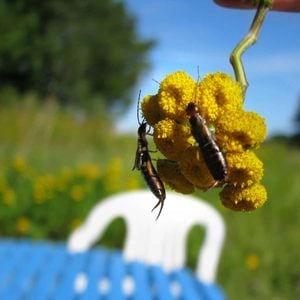
While there are many different species of earwigs, they generally maintain quite similar life cycles and body structure. The average earwig’s lifespan is one year. They struggle in colder environments, which is why you will typically find earwigs in warmer climates. As with most insects, earwigs go through the stages of metamorphosis, as their bodies will develop throughout their life to acquire their fully functional physical features.
On This Page
Metamorphosis
Metamorphosis is the process of transformation in an insect in which they grow from an immature form to a fully functioning adult. Earwigs undergo three stages of a simple metamorphosis throughout their lives: egg, nymph, and adult. This a simpler or incomplete metamorphosis since they lack stages of growth such as the larvae and the pupa.
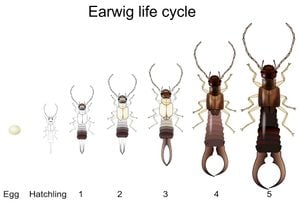
Reproduction – Egg Stage
Earwigs mating season typically occurs in the fall and early winter months. The female carry around their eggs until they find an adequate location to lay them in what is called a cell. This location is typically burrowed into a spot under leaves, in soil, or in a crevice. The female earwig can lay anywhere from 20-80 eggs and can even brood twice in a season. Female earwigs are quite rare in the insect world in that they are one of the few bugs that take care of their eggs.
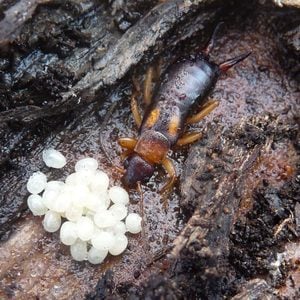
As they lay their eggs in a cell, the mother will look after the eggs, clean them of any parasites or fungi, and will bring back and reposition any eggs that get separated from the cell. Once hatched, the mother will continue to provide food to her young until they are ready to fend for their themselves. A mother can carry eggs inside her for an extended period of time, sometimes as long as a few months. Once laid, the eggs will typically hatch after 7 days, where the earwig will experience their first molting.
Baby Earwig – Nymph Stage
As a nymph, which is the stage of baby or juvenile, the earwig will experience 4-6 moltings before they reach the maturity of adulthood. A molting is the process of shedding old skin and shell to make way for new growth. As these nymphs molt, they will continuously grow and gain the features of an adult earwig. This includes growing out their shells, their antennas, their wings, and their pincers.
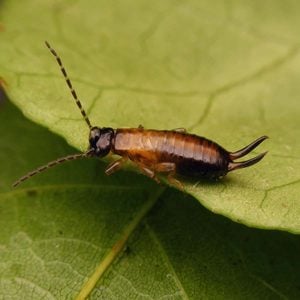
While at first a baby earwig might not look exactly like their adult counterparts, the general shape is still quite similar and distinguishable. Typically, lighter in color, nymphs will grow into their darker, more hardened adult body type in a matter of 40-60 days.
Developed Pincher Bug – Adult Stage
Once an earwig has experienced their last molting, they will be a fully grown and sexually active adult. They are fully winged with functioning antennas and pincers that make them viable to live, eat and hunt all on their own. Their bodies will typically include the following physical features: a head that has two eyes, two antennas about half as long as its body and mouth parts to chew food.
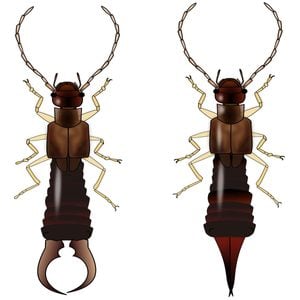
An Earwig’s thorax will contain its six legs, with three on each side. Most earwigs will have two pairs of wings, with one set acting as a leathery cover (front-wings) to protect the other thin, almost silk like nature of the hind-wings. In the back is their abdomen, where all of their blood and circulatory systems are maintained. Protruding from the abdomen is a distinct set of pincers which are used to defend themselves from predators or attack prey. The male’s pincers (left) are more rounded and fierce looking, with the female’s pincers (right) more long and narrow. These pinchers are how they get their nickname, the “pincher bug“. An earwig will often be of dark reddish-brown coloration.
Earwig Infestations
Earwig infestations are quite rare to come across, as they are considered a more individual insect, not belonging to a queen or colony. Finding large numbers grouped together a part of a family or true infestation is unlikely. That said, it is possible to find a handful or even dozens in one location if it is one that replicates their ideal environment.
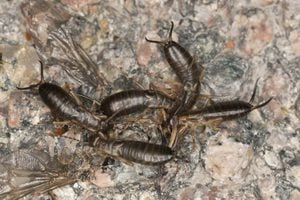
Earwigs do not reproduce indoors nor do they tend to spend long periods of time there. But if there is location that is cool and moist, such as a basement with leaky pipes or humid atmosphere, earwigs may venture there to escape the dry heat of the sun. Outdoors, you might find a few of them lurking in the soil or around vegetation surrounding the house. Since they like to feed on dead plants or leaves, gardens close to the house that provide a consistent food source and comfortable home could be a place where numerous earwigs are found.
How to Handle an Earwig Infestation
The key to understanding earwigs is knowing what they want and need. Earwigs are a simple insect in that they constantly look for food and safety. They aren’t aggressive and generally don’t stick with a family of earwigs. With that knowledge, eliminating an earwig’s food sources (dead leaves, sweet fruits, vegetation) and taking away their safety (leaf piles, old logs, tree stumps, overhanging trees and shrubs, wet spots) can be an effective way of keeping infestations out and away from the home.
Additional Earwig Information
For more information about earwigs and what it means when you find this pest in your home, check out these pest control articles.
- Earwig Guide
- Types of Earwigs
- Earwig Life Cycle
- Earwig Infestations
- How to Get Rid of Earwigs
- How to Prevent Earwigs
- Earwig Safety
- Earwig Facts